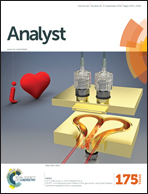Novel carbon-fiber microelectrode batch fabrication using a 3D-printed mold and polyimide resin†
Abstract
Glass insulated carbon-fiber microelectrodes (CFMEs) are standard tools for the measurement of neurotransmitters. However, electrodes are fabricated individually and the glass can shatter, limiting application in higher order mammals. Here, we developed a novel microelectrode batch fabrication method using a 3D-printed mold and polyimide resin insulating agent. The 3D-printed mold is low cost, customizable to change the electrode shape, and allows 40 electrodes to be made simultaneously. The polyimide resin is biocompatible, quick to cure, and does not adhere to the plastic mold. The electrodes were tested for the response to dopamine with fast-scan cyclic voltammetry both in vitro and in vivo and performed similarly to traditional glass-insulated electrodes, but with lower background currents. Thus, polyimide-insulated electrodes can be mass-produced using a 3D-printed mold and are an attractive alternative for making cheap, biocompatible microelectrodes.

- This article is part of the themed collection: In memory of Craig Lunte


 Please wait while we load your content...
Please wait while we load your content...